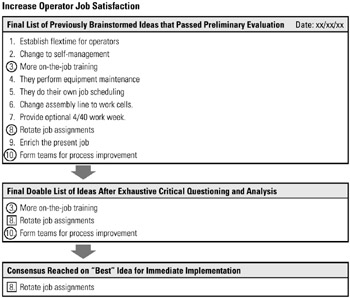Tool 167: Reverse Brainstorming
| AKA | Teardown Method |
| Classification | Evaluating/Selecting (ES) |
Tool description
Reverse brainstorming can be used as a final evaluation technique through the critical questioning of the value or applicability of previously team-generated ideas. In addition, this process attempts to uncover potential problems or other serious consequences when an idea or proposed solution is implemented.
Typical application
-
To minimize the risk prior to the implementation of an idea or proposed solution.
-
To reverse brainstorm ideas for weaknesses or serious consequences.
-
To criticize ideas for the purpose of reducing many to a few overall "best" ideas.
Problem-solving phase
| → | Select and define problem or opportunity |
| → | Identify and analyze causes or potential change |
| → | Develop and plan possible solutions or change |
| Implement and evaluate solution or change | |
| Measure and report solution or change results | |
| Recognize and reward team efforts |
Typically used by
| Research/statistics | |
| 1 | Creativity/innovation |
| Engineering | |
| Project management | |
| Manufacturing | |
| Marketing/sales | |
| Administration/documentation | |
| 3 | Servicing/support |
| Customer/quality metrics | |
| 2 | Change management |
before
-
Data Collection Strategy
-
Surveying
-
Interview Technique
-
Observation
-
Checklist
after
-
Action and Effect Diagram (AED)
-
Sticking Dots
-
Multivoting
-
Weighted Voting
-
Nominal Group Technique (NGT)
Notes and key points
-
Team size should be limited to the 8–12 participants who previously generated the list of ideas.
-
Reverse brainstorming may not be appropriate to use for more than 10 ideas.
-
Since this tool promotes criticisms or the severe questioning of previously generated ideas, care must be taken not to "tear down" every good idea!
Step-by-step procedure
-
STEP 1 The team displays a final list of previously brainstormed ideas that passed preliminary evaluation—a reduced list at this point. See example Increase Operator Job Satisfaction.
-
STEP 2 One by one, all ideas are questioned or criticized for possible shortcomings, problems, weaknesses, or serious consequences if implemented.
-
STEP 3 After all ideas have been evaluated and the potential solutions to problem areas of each idea considered and analyzed, the team selects one (or more) "best" idea that would hold a minimum amount of risk when implemented.
Example of tool application

EAN: 2147483647
Pages: 326